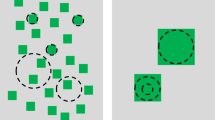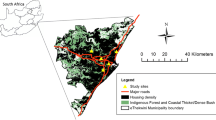Abstract
Context
The habitat amount hypothesis (HAH) posits that local species richness is driven more by the amount of habitat in the surrounding landscape than by local patch size or habitat configuration. Habitat amount and configuration influence patch attributes, however, making it difficult to isolate these relative effects on local richness.
Objectives
We tested the HAH in an experimental system in which the amount (10–80%) and configuration (clumped vs. fragmented) of habitat (red clover) were adjusted independently within individual ‘landscapes’ (256-m2 plots).
Methods
We used generalized linear models and model-selection criteria to evaluate how arthropod richness at two local scales (1 m2 and 4 m2) varied as a function of the amount or fragmentation of habitat and of the size or shape of the local patch.
Results
Local richness was largely independent of the amount or configuration of habitat, as well as patch size or shape. Local richness was best modeled as a constant for all surveys but the first, in which fragmentation alone best explained variation in species richness, followed by patch shape (which is an indirect effect of fragmentation). Habitat amount had an overwhelmingly positive effect on arthropod richness at the landscape scale, however.
Conclusions
The HAH was not supported in this experimental system: local richness was generally unaffected by the amount of habitat in the surrounding landscape, whereas habitat configuration was sometimes important. Given that habitat amount affected landscape-wide richness, it may be that the HAH only applies at the ‘landscape scale’, at least in this system.



Similar content being viewed by others
Data availability
Will be made available upon reasonable request.
Code availability
Will be made available upon reasonable request.
References
Bartoń K (2020) MuMIn: multi-model inference. R package version 1.43.17. https://CRAN.R-project.org/package=MuMIn
Bolger DT, Suarez AV, Crooks KR, Morrison SA, Case TJ (2000) Arthropods in urban habitat fragments in southern California: area, age and edge effects. Ecol Appl 10:1230–1248
Collinge SK (2000) Effects of grassland fragmentation on insect species loss, colonization, and movement patterns. Ecology 81:2211–2226
Debinski DM, Holt RD (2000) A survey and overview of habitat fragmentation experiments. Conserv Biol 14:342–355
Didham RK, Kapos V, Ewers RM (2012) Rethinking the conceptual foundations of habitat fragmentation research. Oikos 121:161–170
Fahrig L (2003) Effects of habitat fragmentation on biodiversity. Annu Rev Ecol Syst 34:487–515
Fahrig L (2013) Rethinking patch size and isolation effects: the habitat amount hypothesis. J Biogeogr 40:1649–1663
Fahrig L (2015) Just a hypothesis: a reply to Hanski. J Biogeogr 42:989–994
Fahrig L (2017) Ecological responses to habitat fragmentation per se. Annu Rev Ecol Evol Syst 48:1–23
Fletcher RJ Jr, Didham RK, Banks-Leite C, Barlow J, Ewers RM, Rosindell J, Holt RD, Gonzalez A, Pardini R, Damschen EI, Melo FP (2018) Is habitat fragmentation good for biodiversity? Biol Conserv 226:9–15
Haddad NM, Gonzalez A, Brudvig LA, Burt MA, Levey DJ, Damschen EI (2017) Experimental evidence does not support the habitat amount hypothesis. Ecography 40:48–55
Hanski I (2015) Habitat fragmentation and species richness. J Biogeogr 42:989–993
Haynes KJ, Crist TO (2009) Insect herbivory in an experimental agroecosystem: the relative importance of habitat area, fragmentation, and the matrix. Oikos 118:1477–1486
Herse MR, With KA, Boyle WA (2020) Grassland fragmentation affects declining tallgrass prairie birds most where large amounts of grassland remain. Landsc Ecol 35:2791–2804
Lawton JH (1999) Are there general laws in ecology? Oikos 84:177–192
Lomolino MV (2000) Ecology’s most general, yet protean pattern: the species–area relationship. J Biogeogr 27:17–26
Lomolino MV, Weiser MD (2001) Towards a more general species–area relationship: diversity on all islands, great and small. J Biogeogr 28:431–445
Martin CA (2018) An early synthesis of the habitat amount hypothesis. Landsc Ecol 33:1831–1835
McGarigal K, Cushman SA (2002) Comparative evaluation of experimental approaches to the study of habitat fragmentation effects. Ecol Appl 12:335–345
R Core Team (2019) R: A language and environment for statistical computing. R Foundation for Statistical Computing, Vienna, Austria. https://www.R-project.org/
Saura S (2021) The habitat amount hypothesis implies negative effects of habitat fragmentation on species richness. J Biogeogr 48:11–22
Seibold S, Bässler C, Brandl R, Fahrig L, Förster B, Heurich M, Hothorn T, Scheipl F, Thorn S, Müller J (2017) An experimental test of the habitat-amount hypothesis for saproxylic beetles in a forested region. Ecology 98:1613–1622
Triantis KA, Vardinoyannis K, Tsolaki EP, Botsaris I, Lika K, Mylonas M (2006) Re-approaching the small island effect. J Biogeogr 33:914–923
Watling JI, Arroyo-Rodríguez V, Pfeifer M, Baeten L, Banks-Leite C, Cisneros LM, Fang R, Hamel-Leigue C, Lachat T, Leal IR, Lens L, Possingham HP, Raheem DC, Ribeiro DB, Slade EM, Urbina-Cardona N, Wood EM, Fahrig L (2020) Support for the habitat amount hypothesis from a global synthesis of species density studies. Ecol Lett 23:674–681
Wiens JA, Milne BT (1989) Scaling of ‘landscapes’ in landscape ecology, or, landscape ecology from a beetle’s perspective. Landsc Ecol 3:87–96
With KA (1997) The application of neutral landscape models in conservation biology. Conserv Biol 11:1069–1080
With KA (2016) Are landscapes more than the sum of their patches? Landsc Ecol 31:969–980
With KA, King AW (1999) Dispersal success in fractal landscapes: a consequence of lacunarity thresholds. Landsc Ecol 14:73–82
With KA, Pavuk DM (2011) Habitat area trumps fragmentation effects on arthropods in an experimental landscape system. Landsc Ecol 26:1035–1048
With KA, Pavuk DM (2012) Direct versus indirect effects of habitat fragmentation on community patterns in experimental landscapes. Oecologia 170:517–528
With KA, Pavuk DM (2019) Habitat configuration matters when evaluating habitat-area effects on host-parasitoid interactions. Ecosphere 10(2):e02604
With KA, Pavuk DM, Worchuck JL, Oates RK, Fisher JL (2002) Threshold effects of landscape structure on biological control in agroecosystems. Ecol Appl 12:52–65
Acknowledgements
We appreciate the thoughtful comments and suggestions provided by two anonymous reviewers of the manuscript. We owe an enormous debt of gratitude to Daniel M. Pavuk, who assisted with establishing and maintaining this experimental system and conducted the arthropod surveys. This paper stems from a partnership between Kansas State University and the University-Level Research Mentorship Program at Manhattan High School. We therefore thank Janet Hanson at MHS for initiating this program and helping to connect high school seniors with prospective university research mentors.
Funding
This research was initially supported by a grant from the National Science Foundation (Grant No. DEB-9610159).
Author information
Authors and Affiliations
Contributions
Both authors contributed to the conceptualization and design of the analysis. Data abstraction and entry were performed by ARP, the code was written by KAW, and both authors conducted the analyses. The manuscript was written by KAW and ARP read and approved the manuscript.
Corresponding author
Ethics declarations
Conflict of interest
The authors have no conflicts of interest or competing interests to declare that are relevant to the content of this article.
Additional information
Publisher's Note
Springer Nature remains neutral with regard to jurisdictional claims in published maps and institutional affiliations.
Supplementary Information
Below is the link to the electronic supplementary material.
Rights and permissions
About this article
Cite this article
With, K.A., Payne, A.R. An experimental test of the habitat amount hypothesis reveals little effect of habitat area but transient or indirect effects of fragmentation on local species richness. Landscape Ecol 36, 2505–2517 (2021). https://doi.org/10.1007/s10980-021-01289-5
Received:
Accepted:
Published:
Issue Date:
DOI: https://doi.org/10.1007/s10980-021-01289-5




